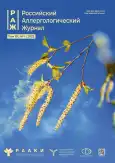Анализ изменений в новой редакции европейских клинических рекомендаций по крапивнице пересмотра 2020 года
- Авторы: Данилычева И.В.1, Шульженко А.Е.1
-
Учреждения:
- Государственный научный центр «Институт иммунологии» Федерального медико-биологического агентства
- Выпуск: Том 19, № 1 (2022)
- Страницы: 142-151
- Раздел: Клинические рекомендации
- URL: https://journals.rcsi.science/raj/article/view/121727
- DOI: https://doi.org/10.36691/RJA1523
- ID: 121727
Цитировать
Полный текст
Аннотация
Текущие европейские клинические рекомендации по лечению крапивницы созданы по инициативе секции дерматологии Европейской академии аллергологии и клинической иммунологии, Европейского консорциума по изучению аллергических заболеваний и бронхиальной астмы, сети центров компетенции и передового опыта по диагностике и ведению крапивницы и ангиоотёка, Европейского дерматологического форума, Азиатско-Тихоокеанской ассоциации аллергии, астмы и клинической иммунологии. Данные клинические рекомендации были приняты Европейским союзом медицинских специалистов. Цель руководства ― дать определение и классификацию крапивницы, причин, провоцирующих факторов, сопутствующих заболеваний, бремени заболевания для пациентов и общества, а также представить последние достижения в диагностике и лечении пациентов с хронической крапивницей.
В статье проведён анализ изменений в новой редакции европейских клинических рекомендаций по крапивнице пересмотра 2020 года. Изменения касаются расширения целей диагностического обследования пациентов, увеличения объёма обязательного обследования. Повышен уровень убедительности рекомендаций по оценке активности и контроля хронической спонтанной крапивницы, влияния болезни на качество жизни пациентов. Лечение, адекватное уровню контроля заболевания, должно изменяться в соответствии с принципом «оценить-действовать-скорректировать». В новой редакции изменена схема ступенчатого подхода к лечению крапивницы: первая линия объединена со второй. Существенным изменением стали рекомендации увеличения дозы омализумаба до 600 мг и уменьшения интервала до 2 нед у пациентов с недостаточным эффектом.
Цель создания клинических рекомендаций в целом ― обеспечение информационной поддержки принятия врачом решений, способствующих повышению качества оказания медицинской помощи пациенту с тем или иным заболеванием / состоянием / синдромом с учётом новейших клинических данных и принципов доказательной медицины.
Полный текст
Открыть статью на сайте журналаОб авторах
Инна Владимировна Данилычева
Государственный научный центр «Институт иммунологии» Федерального медико-биологического агентства
Автор, ответственный за переписку.
Email: ivdanilycheva@mail.ru
ORCID iD: 0000-0002-8279-2173
SPIN-код: 4547-3948
к.м.н.
Россия, 115522, Москва, Каширское шоссе, д. 24Андрей Евгеньевич Шульженко
Государственный научный центр «Институт иммунологии» Федерального медико-биологического агентства
Email: shulzhenko_ae@mail.ru
ORCID iD: 0000-0003-0268-9350
SPIN-код: 4584-4915
д.м.н., профессор
Россия, 115522, Москва, Каширское шоссе, д. 24Список литературы
- Zuberbier T., Greaves M.W., Juhlin L., et al. Management of urticaria: a consensus report // J Investig Dermatol Symp Proc. 2001. Vol. 6, N 2. Р. 128–131. doi: 10.1046/j.0022-202x.2001.00023.x
- Zuberbier T., Latiff A.H., Abuzakouk M., et al. The international EAACI/GA²LEN/EuroGuiDerm/APAAACI guideline for the definition, classification, diagnosis, and management of urticarial // Allergy. 2022. Vol. 77, N 3. Р. 734–766. doi: 10.1111/all.15090
- Андреева Н.С., Реброва О.Ю., Зорин Н.А., и др. Системы оценки достоверности научных доказательств и убедительности рекомендаций: сравнительная характеристика и перспективы унификации // Медицинские технологии: оценка и выбор. 2012. № 4. С. 10–24.
- Zuberbier T., Aberer W., Asero R., et al. The EAACI/GA²LEN/EDF/WAO Guideline for the definition, classification, diagnosis, and management of urticaria: the 2013 revision and update // Allergy. 2014. Vol. 69, N 7. Р. 868–887. doi: 10.1111/all.12313
- Kolkhir P., Kovalkova E., Chernov A., et al. Autoimmune chronic spontaneous urticaria detection with IgG anti-TPO and total IgE // J Allergy Clin Immunol Pract. 2021. Vol. 9, N 11. Р. 4138–4146.e8. doi: 10.1016/j.jaip.2021.07.043
- Türk M., Carneiro-Leão L., Kolkhir P., et al. How to treat patients with chronic spontaneous urticaria with omalizumab: questions and answers // J Allergy Clin Immunol Pract. 2020. Vol. 8, N 1. Р. 113–124. doi: 10.1016/j.jaip.2019.07.021
Дополнительные файлы










